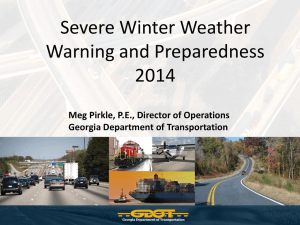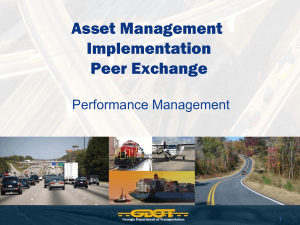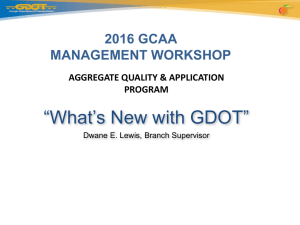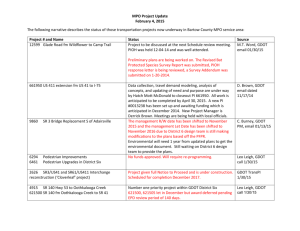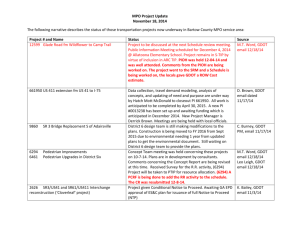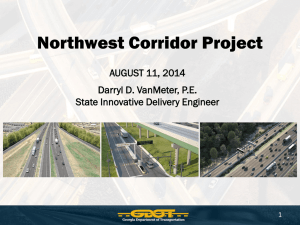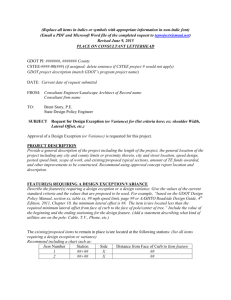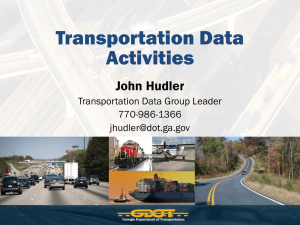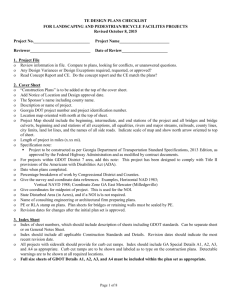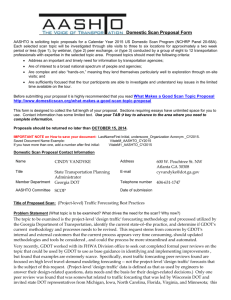Archaeology GPTQ Meeting Minutes August 8, 2013
advertisement
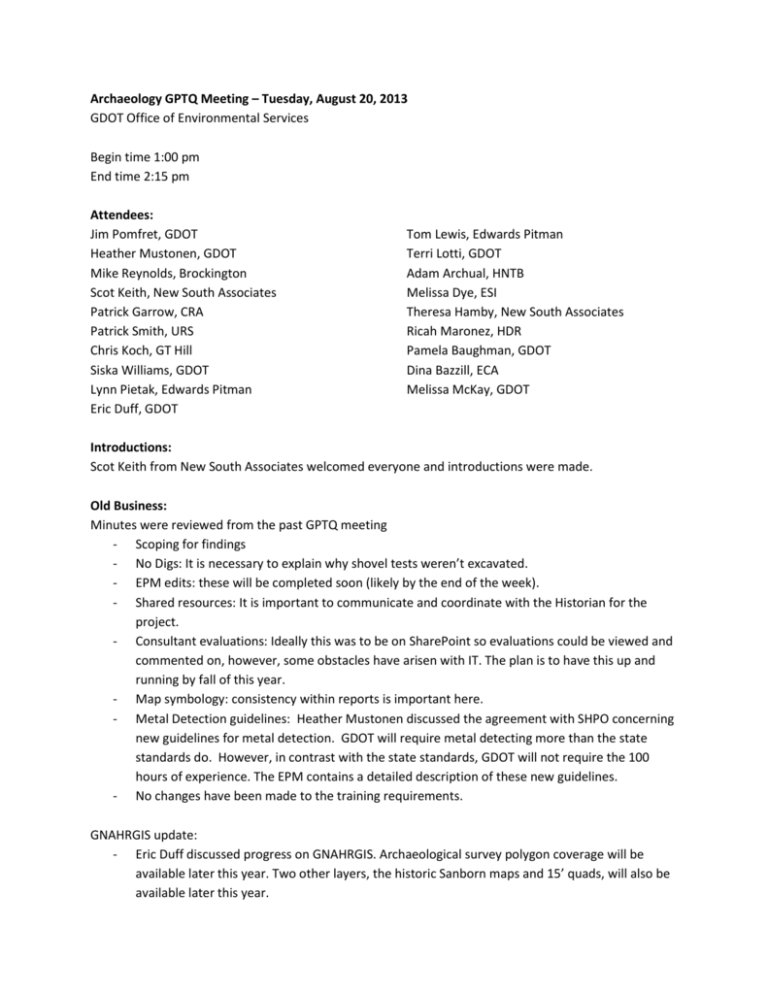
Archaeology GPTQ Meeting – Tuesday, August 20, 2013 GDOT Office of Environmental Services Begin time 1:00 pm End time 2:15 pm Attendees: Jim Pomfret, GDOT Heather Mustonen, GDOT Mike Reynolds, Brockington Scot Keith, New South Associates Patrick Garrow, CRA Patrick Smith, URS Chris Koch, GT Hill Siska Williams, GDOT Lynn Pietak, Edwards Pitman Eric Duff, GDOT Tom Lewis, Edwards Pitman Terri Lotti, GDOT Adam Archual, HNTB Melissa Dye, ESI Theresa Hamby, New South Associates Ricah Maronez, HDR Pamela Baughman, GDOT Dina Bazzill, ECA Melissa McKay, GDOT Introductions: Scot Keith from New South Associates welcomed everyone and introductions were made. Old Business: Minutes were reviewed from the past GPTQ meeting - Scoping for findings - No Digs: It is necessary to explain why shovel tests weren’t excavated. - EPM edits: these will be completed soon (likely by the end of the week). - Shared resources: It is important to communicate and coordinate with the Historian for the project. - Consultant evaluations: Ideally this was to be on SharePoint so evaluations could be viewed and commented on, however, some obstacles have arisen with IT. The plan is to have this up and running by fall of this year. - Map symbology: consistency within reports is important here. - Metal Detection guidelines: Heather Mustonen discussed the agreement with SHPO concerning new guidelines for metal detection. GDOT will require metal detecting more than the state standards do. However, in contrast with the state standards, GDOT will not require the 100 hours of experience. The EPM contains a detailed description of these new guidelines. - No changes have been made to the training requirements. GNAHRGIS update: - Eric Duff discussed progress on GNAHRGIS. Archaeological survey polygon coverage will be available later this year. Two other layers, the historic Sanborn maps and 15’ quads, will also be available later this year. - Online site form submission is currently being discussed with Site Files and will become live in late 2014. There is a possibility for a name change for GNAHRGIS. Is this necessary? Let Eric know opinions. New Business: Environmental Procedures Manual Cultural Resource Updates - Siska Williams briefly discussed underwater archaeology guidelines and that they are outlined in the updated EPM. - Jim Pomfret discussed the ESC waiver. If the ESC doesn’t seem necessary contact Jim to discuss. - A copy of a landowner letter is required in reports along with the list of recipients. - ESAs are to be included in reports. - Shared resources are more detailed in the updated EPM; it is important to coordinate with the project historian. - Siska Williams discussed the new cemetery procedures. These procedures can also be adapted to other shared resources. o Handling cemeteries on projects has been confusing in the past. The new procedures will reduce miscommunication between archaeologists and historians. - Eric Duff commented that a statewide cemetery context is currently being developed, and will be completed within a year to a year and a half. GDOT Report Review Process: Jim Pomfret addressed the comments and questions consultants had concerning the GDOT process of reviewing reports. 1. Issue: Having to add information to cultural or environmental contexts that does not pertain to the findings, e.g. add lithic material sources when no prehistoric sites were found or adding more prehistoric background information when no prehistoric sites were found. Response: Context should be completed prior to fieldwork and is not based on findings. Background research informs the archaeologist of expectations. This is addressed in the Archaeological Report Guidelines. 2. Issue: Having to do additional research and add information that is not particularly relevant to findings. Response: Similar to prior issue. This is addressed in the Report Guidelines. 3. Issue: Asked not to start a sentence with the word “this” even though it is referring directly to the subject of the previous sentence(s) and is not ambiguous. Response: It is necessary to address this issue when two or more topics are being discussed and it is unclear which topic “this” is referring to. 4. Issue: State site forms: asked to add North arrow and scale to topo map even though this is not necessary since they are always at standard 1:24K scale and north is always towards the top of the page on USGS topos. A random sampling of state site forms shows that this is simply not done. Also, asked to remove surrounding sites to show only the subject site on these and sketch maps – however, showing surrounding sites provides a context for understanding the site distribution in the immediate area of the subject site. Response: Site Files should handle maps on site forms; they have their own standards and requirements for topo maps and GDOT will not comment on this. GDOT may, however, comment on sketch maps and other maps within reports. 5. Issue: Are maps of STs always to be done in the Management Summary for surveys – some reviewers require them, others do not. Response: Maps of shovel tests should be provided. When an issue arises with larger surveys, this is more of a scoping issue (having to provide these maps in a short period of time). GDOT archaeologists will discuss this issue internally. 6. Issue: Are artifact photos needed for every site, particularly if they are not very informative or photogenic (rusted nail, clear bottle glass, flake)? This stems from request for such in report review comments. Response: The Report Guidelines state that “photographs and/or drawings of representative types and diagnostic artifacts” are to be included (Archaeology Report Guidelines Page 7). 7. Issue: How are consultants to know which specific things to include in report when it is not consistent? Such issues lead to extra time and money, and also delays in the project schedule. Response: It is important to follow the Report Guidelines as closely as possible. Also, we are all individuals with his or her own style of reviewing reports, just as each author has his or her own style of writing reports. If a comment is not understood the issue should be discussed between the report author and reviewer. Return to New Business: - Jim Pomfret noted that the EPM updates will be completed very soon. Some changes and/or additions include: o Appendix Requirements: A copy of the sent landowner letter, along with a list of recipients, is to be included. If the letters were sent by someone else then they shall be obtained from the person who sent them and included in the appendix. Copies of permits will be required. Examples include an ARPA or cemetery permits. Copies of layouts/plans/design concepts used for survey are to be included. Knowing exactly what areas were surveyed is helpful for potential future surveys associated with or nearby the project. If the layouts are too large, a PDF version can be obtained from the designer. - Pam Baughman discussed curation and the new certification form that is to be included with the collection. - Jim Pomfret discussed project change procedures: o Memos to File v. Addendum reports: If there is a change within the originally surveyed area then a Memo to File is required. If the changes go beyond that surveyed area, new documentation is required to inform SHPO. - Jim Pomfret discussed isolated finds. Soon, a Short Form will be sufficient for documenting isolated finds.

